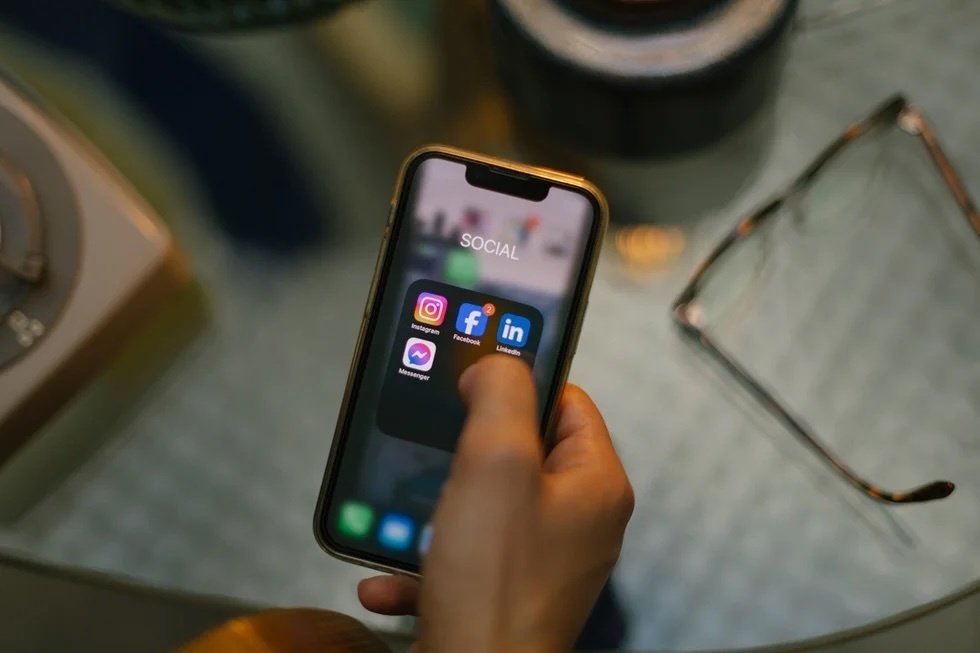Using Instagram or Twitter to contact recruiters: Genius or risky?
Dec 13, 2023
6 mins


Rédactrice et consultante QVCT
Recruiters (both internal and external) use social media to find candidates, post job ads, and even develop their company brand, so should candidates be making use of the same tools to establish direct contact with potential future employers?
Using social media to look for a job isn’t exactly groundbreaking. A 2023 Content Stadium found that 98% of companies used social media to recruit, while another showed that 85% of jobseekers do. LinkedIn and Facebook are used to respond to job offers and send resumes but also to enlist the help of professional and personal networks.
If you’ve ever applied for a job on LinkedIn, you’ll know that the feature that shows the number of candidates who have already applied can often be discouraging … How can you stand out from the hundred candidates who’ve already applied within hours of the job being posted? It’s getting harder and harder, so job seekers have been seeking increasingly inventive ways to attract attention to their applications. A few years ago we saw a flurry of dynamic resumes on LinkedIn—visual, entertaining resumes as posters and flipbooks—today you might want to try contacting recruiters directly on social media, but is it a good idea?
Is contacting a recruiter on social media a good idea?
LinkedIn: The professional network of choice
LinkedIn gives the impression of easy access to just about anyone on there, a dizzying thought when you’re looking for a job. Who hasn’t had the fleeting thought of, “I’m just going to ping the managing director of the company a DM. Who knows, they might even offer me a job!” In theory, a simple click is all it takes to contact all the recruiters and managing directors on the platform. If you subscribe to the, “He who dares wins” culture, then this kind of job-seeking strategy might work for you. And, as LinkedIn is a social media site aimed at the world of work, you can get straight out of the starting blocks without having to worry too much about not staying in your lane or shocking people by suddenly popping up in their notifications.
When she was looking for a work experience placement, Lea decided that she had to do more than just reply to ads: “I searched the names of people who could potentially make use of an intern on company and public sector websites that I liked the look of. I found someone and contacted him on LinkedIn. It didn’t work, but he did reply!”
Her proactive approach paid off in the end because she got her placement by contacting some former students on her course via email and LinkedIn. “I think it comes across well because it shows your motivation. However, looking back I guess it could be annoying if lots of people are doing it.”
Facebook and Instagram
If approaching people on LinkedIn carries a risk of being annoying, then using Instagram or Twitter can be a slippery slope. These platforms are less professional and formal and are not necessarily designed for work.
Thirsty-something Simon who works in the web industry didn’t let that put him off. He has used Facebook several times throughout his job search. “I found a video games studio that worked on a game I love, so I started looking up their employees on Facebook. I was able to contact one of the level designers through a mutual contact. We talked a lot, and he told me I should be part of the studio. So I bombarded the two studio heads with messages—on Viadeo and LinkedIn—asking them for an interview. This interview turned into a taster day at the studio which ended in a job offer. I worked there for a year and a half. As for my current job, you could also say I got that through social media as I contacted the company on Facebook first before getting a meeting with the boss where I gave him my application.”
For Sabine, a freelance journalist, it was Instagram that helped her find contacts and develop her professional network. Her method was to take note of journalists whose work she found interesting, and then follow them on Instagram. “I feel like my Insta feed represents me much better than a resume sent through a dehumanized platform,” she explains. It’s the warmer approach that attracted Sabine to this way of working: “Friendly relationships have developed over time, and I’ve even got to work with one of the media outlets I contacted this way.”
However, her efforts haven’t led to long-term employment as yet. “Although I landed an interview with a magazine, sadly it didn’t go anywhere as there were no [full-time] vacancies at the time. I think using social media is a lot more relaxed than LinkedIn, even though I use that too. Contacts are made more naturally, you can react to stories, talk about your day-to-day, and connect before getting down to the nitty gritty of the job hunt.”
Are all social media platforms fair game?
These different stories show that, to a certain extent, the strategy of getting a foot in the door works. On the other hand, while it’s good to dare to reach out, and on the whole, it’s appreciated, you have to be careful and have some limits.
Employment expert and co-founder of Talent Management Group, Amelie Favre Guittet, takes a pragmatic and uncomplicated approach, “Many HR workers have Twitter [X] accounts to monitor topics and it’s a goldmine for conversations. Twitter [X] is an excellent way to find clients and candidates, so why not your future boss?”
Sabine and Simon’s stories, using Facebook and Instagram among others, are targeted at rather specific sectors or organizations: journalism and video games. Would they have received the same welcome in a different sector? How do you know where the line is?
Questions to ask before contacting a recruiter on social media
Doing your own research is the best way to figure out your approach. Favre Guittet shares a few tips to get you started:
- Ask yourself about who your target is and where they spend their time, so you can choose the right social media platform.
- Find something that you have in common so you can start a conversation (an interest in a specific subject, alumni, etc.) Favre Guittet often advises the people she supports to join LinkedIn interest groups: “You can join ten or so and then you’ll be able to have unlimited contact with each of the members.”
- Be succinct: LinkedIn users spend typically spend around ten minutes on the platform. “If a candidate sends a resume with a super long cover letter and expects us to remember them and offer them a job, it’s not going to work!” she explains.
- Think about marketing yourself (take a look at Lemlist or Hubspot for guidance). “You’re the product in this scenario—your profile, your personality, your skills, you need to make people want you, and to do that there are certain rules.”
- Find the right person, “You can write to anyone, as long as you get it right and take an interest in the other person first. You can contact someone in HR, a recruitment manager, or an expert in the area you’re interested in. But if you want it to come to something, choose wisely.”
- Show a real interest in the other person. “When you flirt with someone on a night out, you don’t stroll up to them and say, ‘Hey do you want to get laid?’ right off the bat. On LinkedIn, it’s kind of the same. Before sending your resume, the person needs to want to know more about you. It’s only after you’ve indulged in a bit of chit-chat that you can ask if a profile like yours might be of interest. If they ask for your resume, then you have the green light for a more targeted introduction. The relationship won’t be the same if you just spam them with resumes,” explains Favre Guittet.
Follow up, “You can touch base with the person every three to four days without issues, and up to four or five times in total.”
Keep in mind: If you’re unsure about which platform to use, opt for LinkedIn. It’s the most appropriate for work, especially with more traditional company cultures.
More tips and tricks for reaching out on social media
- Don’t contact your target directly: If you want to work for Deloitte in finance, you can contact someone who has a completely different role and ask if they know who’s in charge of recruitment. They won’t feel like they’re competing with you and will likely be more open. Then you can contact the person they send you to, saying that this person advised you to get in touch. It gives you more legitimacy and increases your chances of being read with interest.
Tip: Don’t forget to keep your first contact up to date with how your search is going.
- Adapt your writing and speech: Social media networks break the habit of formalism so we can use more simple terms while still keeping some boundaries and respect. No need to bother with Sir/Madam or yours faithfully …
- Practice: Favre Guittet advises candidates to write down what they’d say to the HR director if they were sitting face-to-face. Then, edit the message to cut it down to half so you get to what’s essential. It’ll make your message clearer and more direct.
Lastly, job-seeking via social media often requires a bit of detective work. It starts with knowing what you want (not always easy!) and translating that into a selection of jobs, companies, and sectors. In the competitive world of work and recruitment, it would be a shame to overlook additional tools, like social media. Whether you’re team ‘foot in the door’, team ‘bombard them with messages on Instagram’, or team ‘send a timid invitation sharing an article you think they’ll find interesting’, social media can be your greatest ally in the job search, as long as you use it in a way that matches your aspirations and the employers you want to target.
Translated by Debbie Garrick
Photo: Welcome to the Jungle
Follow Welcome to the Jungle on Facebook, LinkedIn, and Instagram, and subscribe to our newsletter to get our latest articles every week!

More inspiration: Network for the job hunt

Messaging recruiters: 7 mistakes to avoid on LinkedIn
Think messaging a recruiter on LinkedIn guarantees an interview? Not if you make these mistakes. Here's how to get noticed for the right reasons.
Dec 02, 2024

From tech to television: the benefits of alumni networking
Using your alumni network can be a game-changer for your career, allowing you to connect with people who share your background and experiences.
Jul 30, 2024

How to network in tech with no experience
Networking can be daunting for anyone, but entry-level tech workers have a unique challenge ahead.
May 30, 2024

Make your mark: How to build a personal brand for the job hunt
What’s the secret to success in today’s job market? None other than personal branding.
Apr 22, 2024

Telling your story: How to craft a LinkedIn bio that will stand out to recruiters
This social media tool is at the tip of your fingers, and we bet you don’t know what you’re missing …
Feb 13, 2024
The newsletter that does the job
Want to keep up with the latest articles? Twice a week you can receive stories, jobs, and tips in your inbox.

Looking for your next job?
Over 200,000 people have found a job with Welcome to the Jungle.
Explore jobs